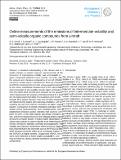Online measurements of the emissions of intermediate-volatility and semi-volatile organic compounds from aircraft
Author(s)
Herndon, S. C.; Jayne, John T.; Worsnop, D. R.; Miake-Lye, R. C.; Cross, Eben Spencer; Hunter, James; Carrasquillo, Anthony Joseph; Franklin, Jonathan Pfeil; Kroll, Jesse; ... Show more Show less
DownloadCross-2013-Online measurements.pdf (3.297Mb)
PUBLISHER_CC
Publisher with Creative Commons License
Creative Commons Attribution
Terms of use
Metadata
Show full item recordAbstract
A detailed understanding of the climate and air quality impacts of aviation requires measurements of the emissions of intermediate-volatility and semi-volatile organic compounds (I/SVOCs) from aircraft. Currently both the amount and chemical composition of aircraft I/SVOC emissions remain poorly characterized. Here we characterize I/SVOC emissions from aircraft, using a novel instrument for the online, quantitative measurement of the mass loading and composition of low-volatility organic vapors. Emissions from the NASA DC8 aircraft were sampled on the ground 143 m downwind of the engines and characterized as a function of engine power from idle (4% maximum rated thrust) through 85% power. Results show that I/SVOC emissions are highest during engine idle operating conditions, with decreasing but non-zero I/SVOC emissions at higher engine powers. Comparison of I/SVOC emissions with total hydrocarbon (THC) measurements, VOC measurements, and an established emissions profile indicates that I/SVOCs comprise 10–20% of the total organic gas-phase emissions at idle, and an increasing fraction of the total gas-phase organic emissions at higher powers. Positive matrix factorization of online mass spectra is used to identify three distinct types of I/SVOC emissions: aliphatic, aromatic and oxygenated. The volatility and chemical composition of the emissions suggest that unburned fuel is the dominant source of I/SVOCs at idle, while pyrolysis products make up an increasing fraction of the I/SVOCs at higher powers. Oxygenated I/SVOC emissions were detected at lower engine powers (≤30%) and may be linked to cracked, partially oxidized or unburned fuel components.
Date issued
2013-08Department
Massachusetts Institute of Technology. Department of Chemical Engineering; Massachusetts Institute of Technology. Department of Civil and Environmental EngineeringJournal
Atmospheric Chemistry and Physics
Publisher
Copernicus GmbH
Citation
Cross, E. S., J. F. Hunter, A. J. Carrasquillo, J. P. Franklin, S. C. Herndon, J. T. Jayne, D. R. Worsnop, R. C. Miake-Lye, and J. H. Kroll. “Online measurements of the emissions of intermediate-volatility and semi-volatile organic compounds from aircraft.” Atmospheric Chemistry and Physics 13, no. 15 (August 14, 2013): 7845-7858.
Version: Final published version
ISSN
1680-7324
1680-7316